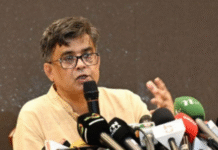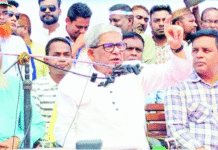The partial lifting of a communications blackout is providing a picture of the young victims of a brutal crackdown on protesters. Thousands of others have been swept into jails.

Mujib Mashal and
Mujib Mashal reported from New Delhi, and Saif Hasnat from Dhaka, Bangladesh.
A part-time tutor, shot in the neck and killed. A journalist and young father, felled by a bullet to the head. A shopkeeper’s son, also fatally shot in the head.
When Bangladesh’s near-total communications blackout was partially lifted last week after a vicious crackdown on a student-led protest, one of the first things to emerge online was a digital yearbook of the dead.
It put names and faces to days of carnage unleashed by government forces seeking to quell what had begun as a peaceful demonstration against quotas that reserve sought-after government jobs for specific groups. Conservative estimates put the death toll at near 200. Thousands were injured; in one hospital in the capital, Dhaka, alone, more than 250 people required eye surgeries after being shot in the face by pellets or rubber bullets.
Image

Most of the victims were young, in their 20s. They had been brought together on the streets by the bleak prospects of a stagnating economy. They were also fueled by anger at what they saw as government corruption, cronyism and impunity, as the country’s leaders dismissed their demand for a merit-based distribution of jobs.
-
Hridoy Chandra Tarua, 23, was finishing a history degree and working as a tutor. His father is a carpenter, his mother a housemaid. On the days he returned home from college, he would wash clothes for his mother, grind spices on a stone slab and tell her it was just a matter of time before he got a job that would help ease her toil.
-
Hasan Mehdi, 35, was one of at least three journalists killed. He leaves behind his wife and two young daughters, the oldest a little over 3 years old. “My little daughter has just learned how to say ‘Abu, Abu,’” his wife, Farhana Islam Poppy, said, referring to the word for “father.” “My daughters will never get to know who their dad really was.”
-
Mahmudul Rahman Shoikot, 20, was closing his family’s shop when the crackdown began. He was killed when he rushed to help some injured students, his sister, Sabrina Shabonti, said. At 6-foot-3, he towered over his two sisters, who teased him for how easily and profusely he would sweat during the hours he spent in the sun playing cricket. “When they went to bury him, he was so tall they struggled to fit him into the grave,” Ms. Shabonti said.
For the families of the victims, the immediate task after their deaths was to piece together what had happened to them, to search for their bodies when the phones were down and a curfew restricted movement, and to carry out last rites as the government was trying to hide the toll, bury the evidence and prevent gatherings that could perpetuate the anger.
Only then could they turn to the shattering grief.
“I don’t know if we will ever be able to laugh openly again, to eat the food that was his favorite, or to be truly happy,” Ms. Shabonti said. “My mom cries all day. My dad cries all day. All we think of is him.”
Image

The protest, which has subsided after the crackdown and the curfew, began early this month with a single demand. The students sought an end to a system that carved out about half of all civil service jobs for designated groups, with about 30 percent set aside for the descendants of the “freedom fighters” who liberated the country from Pakistan in the 1970s.
Ms. Hasina’s forces have also continued to try to break the protesters. On Friday, three student leaders — one of whom had been tortured — who were receiving treatment for wounds were picked up from the hospital by law enforcement agents.
Image

Asaduzzaman Khan, the home minister, described the arrests of the three as for their own good. He said that the student leaders had been “threatened and intimidated” by people who wanted them to continue their agitation. “Just for their own safety, we need to interrogate them,” he told reporters late on Friday.
Ms. Hasina has blamed the violence on her sworn enemies in the political opposition, saying they had infiltrated the protest to try to topple her government. At least three police officers were killed, a member of her party was lynched and state property was vandalized.
In the digital yearbook, Abu Sayeed, 25, is listed as death No. 1. In his portrait, he is wearing a bandanna printed with the Bangladeshi flag.
Mr. Sayeed was a student in the northern city of Rangpur. His family, year after year, sold bits of their land to make ends meet. Fiercely independent, he wanted to make a life for himself with a government job away from Rangpur. But he knew that the odds were difficult: A cousin who had completed a master’s degree had still not found government work — which is seen as a path to economic stability — after years of trying.
Mr. Sayeed was incensed that the quotas essentially doubled the competition for civil service jobs. But there was another reason for his resolve in protesting: He had been attacked by members of the youth wing of Ms. Hasina’s party, who started targeting the peaceful protesters after she had likened them to traitors in Bangladesh’s war of independence.
Image

In a video taken before his death, Mr. Sayeed is heard saying that he was slapped in the face. His family said the incident happened a day before his killing.
Another video, from the afternoon of July 16, was spread widely before the internet was shut down. In it, Mr. Sayeed wears a black T-shirt and holds a stick. He stretches his arms wide as police officers aim their guns and open fire. He crouches for a second as a voice in the video says “He’s been shot, he’s been shot.” Then he stands again, and the firing continues.
Most of his wounds were from rubber bullets. But his brother Romjan Ali, who received his corpse, said that Mr. Sayeed had at least one wound from a “real bullet” near his head.
“Sayeed’s anger may have accumulated because of that slap,” Mr. Ali said. “That’s why he put his chest in front of the gun.”
For the family, receiving the body was another harrowing ordeal.
After Mr. Sayeed was declared dead at a hospital, his friends wanted to take his body back to the protest site. But the police snatched it and hid it away. Mr. Ali said that when he arrived at the hospital, it took a couple of hours of searching and pleading to locate his brother’s body.
Only after midnight, after student protesters threatened to attack the hospital if the body was not returned, was it handed over to the family. Officials pressured them to bury Mr. Sayeed before sunrise, which they resisted.
Before giving them the body, the police asked if the family would file a case.
“We said we wouldn’t,” Mr. Ali said. “We were afraid we would not get the body.”
Image

Mujib Mashal is the South Asia bureau chief for The Times, helping to lead coverage of India and the diverse region around it, including Bangladesh, Sri Lanka, Nepal and Bhutan. More about Mujib Mashal









